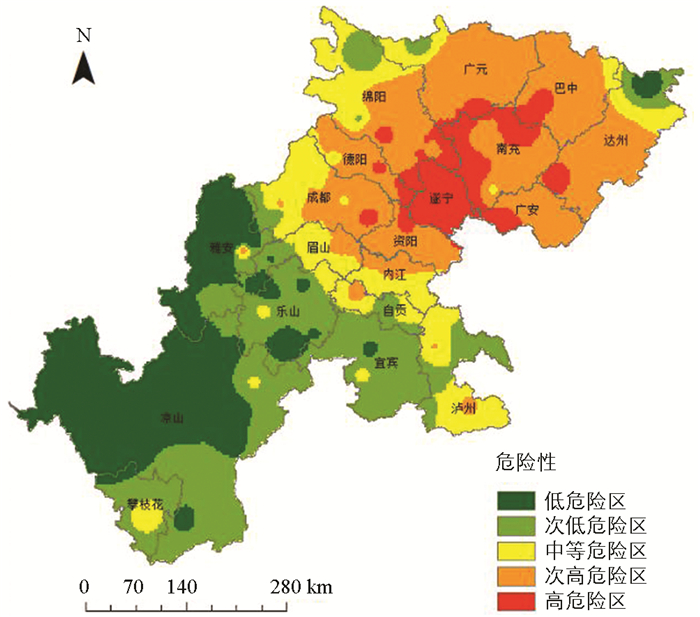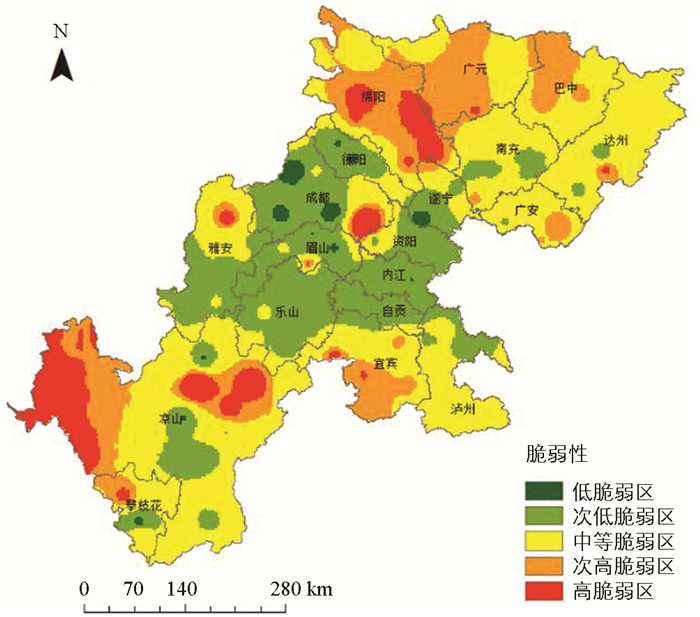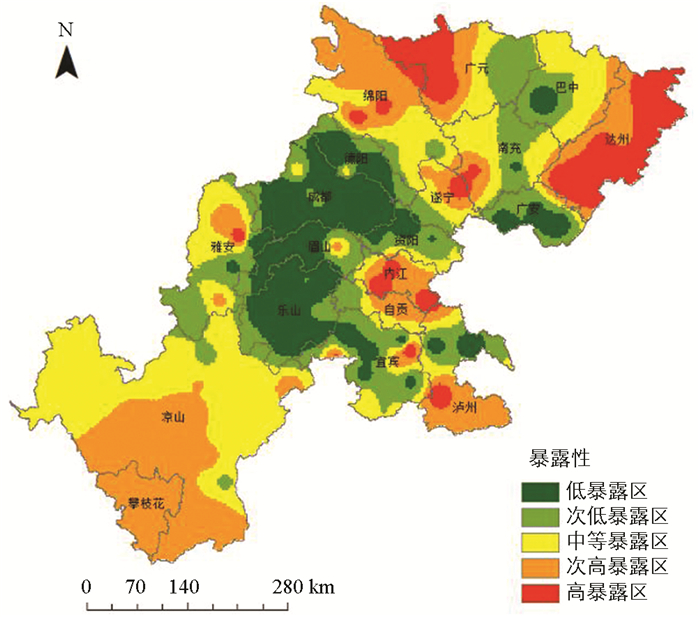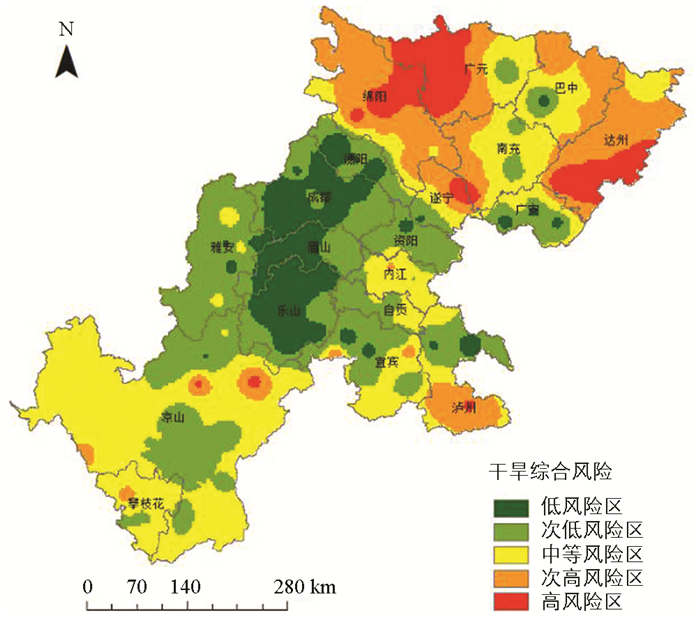-
开放科学(资源服务)标志码(OSID):

-
自古以来,农业一直是与气象条件依存度最高的产业之一,在全球气候变化的大背景下,农业受到的影响最为显著,各类极端气候事件对农业生产的影响也越来越受到国内外学术界的重视,其中干旱是受关注度最高的一种气象灾害[1-2]. 我国水资源虽然丰富,但其分布极为不均,因此,对以农耕为立身之本的中华文明来说,旱涝灾害从几千年前开始就始终存在并不断展示其巨大威力.
目前中国是全球最大的水稻生产国,其中四川是13个粮食主产区之一,水稻产量占全国粮食总产量的6.9%[3-4]. 四川地理位置特殊,地形地貌多样,大气环流复杂,四川水稻生产易受干旱、洪涝、高温、冷害等多种气象灾害的影响,其中又以干旱最为常见,对产量影响最大[5]. 水稻是水生植物,生长过程中需水量大,但在四川省农业生产中,各类水利工程设施覆盖面较小,水稻能够有效灌溉的地区不多,水稻产量很大程度上仍然受自然降水的影响. 因此,研究四川水稻干旱灾害综合风险对水稻生产规划布局有着十分重要的指导意义.
近十几年来,西南地区严重干旱灾害频发,因此针对该地区的干旱研究不断增多. 如张峰[6]对川渝地区农业气象干旱风险与损失进行评估; 张建平等[7]改进相对湿润指数,对西南地区水稻干旱时空分布特征进行评述; 赵海燕等[8]修正综合气象干旱指数并分析其在西南地区的适用程度; 宋艳玲等[9]针对干旱对贵州地区水稻产量的影响进行分析; 王明田等[10]、李金建等[11]、袁淑杰等[12]都基于相对湿润指数分别对西南和四川盆地干旱时空变化特征进行分析. 针对四川地区的水稻干旱,陈超等[13]、陈东东等[14]分别针对水稻不同生育阶段开展干旱风险研究; 庞艳梅等[15]、杨世民等[16]对四川盆区直播与移栽水稻的干旱风险进行了对比评估. 但以上研究或是基于相对湿润指数,或是仅以四川盆地水稻作为研究对象,或是针对水稻某个生育期进行分析,而基于水分亏缺指数[17]对四川全部水稻产区干旱灾害风险的分析评估较少.
本研究基于水分亏缺指数(crop water deficit index,CWDI),从自然灾害形成机制的角度,提出以危险性、脆弱性、暴露性和防旱减灾能力4个要素[18-19]作为种植制度优化评价指数,构建风险评价模型,研究干旱对区域作物种植制度演变的影响,明确干旱气候背景下,各区域种植制度布局如何根据农业气候资源变化进行优化,以期为相关决策生产部门开展农业生产应对气候变化采取相关措施提供科学参考依据.
全文HTML
-
本研究收集了四川省盆地及攀西农区125个气象站点1980-2017年的逐日降水量、平均气温、最高气温、最低气温、日照时数、平均气压、平均水汽压、平均相对湿度、风速以及海拔等数据[20]; 四川省盆地23个及攀西农区3个共计26个水稻农业气象观测站1980-2017年的水稻生育期资料. 现实生产力数据来自于《四川省统计年鉴》.
-
四川省水稻主要分布在四川盆地、盆周山区及川西南山地区域,按地理地貌类型及种植区形成,将全省划分为7个种植区(图 1)及1个非种植区(川西高原区,本文略)[21]. 通过统计水稻农业气象观测站观测报表的生育期资料,结合大田生产调查,得出各区域水稻播种至成熟期全生育阶段的时间. 根据研究需要,现仅将各区域水稻移栽-成熟过程中的所有生育阶段时间列出(表 1).
成都平原区(Ⅰ区)为5月上旬至9月上旬,盆中丘陵区(Ⅱ区)为5月上旬至9月上旬,盆南丘陵低山区(Ⅲ区)为4月上旬至8月上旬,盆东平行岭谷区(Ⅳ区)为5月上旬至8月下旬,盆北深丘低山区(Ⅴ区)为5月下旬至9月下旬,川西南山地半湿润气候区(Ⅵ区)为5月上旬至10月上旬,川西南山地干热河谷区(Ⅶ区)为5月上旬至9月上旬.
-
水稻水分亏缺指数(I)计算公式[22]
式中,P10为前10日累积降水量; W10为前10日累积作物需水量; P为固定时段的累计降水量; W为固定时段累计作物需水量,通过式(2)计算; C为固定区域的径流系数,采用美国土壤保持局的径流曲线法(USDA-SCS,1988a,Sharpley and Williams,1990),通过式(3)和式(4)计算.
式中,ET0为参考作物蒸散量,采用Penman-Monteith公式计算[23]; Kc为作物系数,可由四川省已有资料和田间试验结果计算[24].
式中,P为日降水量; S为表面水分保持力因子,受土壤水分量影响较大.
根据干旱标准结合《中国气象灾害大典》(四川卷),参考盆地区典型年份水稻干旱评估指数,并进行对比分析,确定水稻干旱等级指标,将其分为无旱、轻旱、中旱、重旱、特旱5个级别[27](表 2).
-
干旱频率计算公式[28]
式中,Xh2为干旱频率; Di为某个生育期干旱次数,通过表 2确定; i为第i年份; n为资料总年数,本研究取值为38.
-
通过对水稻干旱频率进行标准化处理,得到水稻干旱灾害风险评价指标:
正向指标(Xij):指标值越大,水稻干旱灾害风险越大.
负向指标(Xij):指标值越大,水稻干旱灾害风险越小.
式中,Xjmin为样本最小值; Xjmax为样本最大值; Xij为干旱灾害风险评价指标.
-
为了研究方便,将水稻全生育期划分为5个主要生育阶段(表 3).
综合考虑四川省水稻各生育阶段特征和影响,本研究采用层次分析法(AHP)对各生育阶段的影响权重进行了划分.
-
水稻各生育阶段干旱灾害危险性指数按式(8)计算
式中,Ht为水稻t生育期干旱灾害危险性指数; X1,X2分别为t生育期的标准化干旱频率和水分盈亏指数; Wt1,Wt2分别是t生育期X1,X2权重,取0.4和0.6.
计算得到各生育阶段水稻干旱灾害危险性指数后,建立水稻全生育期干旱灾害危险性模型为
式中,H为全生育期干旱灾害危险性指数,Qt为各生育阶段干旱危险指数影响权重. 对应表 3各生育期的影响权重采用层次分析法确定,经过计算,分别为0.1,0.1,0.2,0.3,0.3.
-
承灾体的脆弱性越高,则在一定灾变条件下造成的损失或伤害程度越重,风险越高. 选用产量变异程度作为脆弱性评价指标能够从作物敏感性的角度反映出灾年产量损失严重地区脆弱度高的特点. 将产量变异程度用多年单产的标准差与多年单产最大值的比值来表示,模型为
式中,V为脆弱度,Yi为某县第i年单产,Ymax为该县多年单产最大值,n为单产资料总年份数.
-
承灾体暴露于孕灾环境的部分越大,灾害损失的可能性越大,风险也就越高. 暴露性依据研究的侧重点不同选取不同的指标,本研究从《四川省农业统计年鉴》中筛选出全省盆地及攀西地区各种植县的水稻播种面积及耕地面积,用耕地面积与水稻播种面积构建暴露性模型为
式中,E为暴露度,Sbo为县域水稻播种面积,Sall为县域内耕地面积.
-
采用有效灌溉率和人均GDP两个指标来构建防灾减灾能力评价模型,其中有效灌溉率按式(12)计算
式中,T为有效灌溉率; Sg为区域当年有效灌溉面积.
水稻干旱灾害防灾减灾能力指数按式(13)计算
式中,R为水稻干旱灾害防灾减灾能力指数; V1,V2分别为不同地区水稻标准化有效灌溉率和人均GDP指数; U1,U2分别为有效灌溉率和人均GDP指标的权重,取0.6和0.4.
-
农业气象灾害风险是潜在的灾害,本文根据自然灾害形成机制,提出以致灾因子危险性、承灾体脆弱性、暴露性和防灾减灾能力4个方面作为评价因子共同构建综合风险评价模型.
致灾因子危险性、脆弱性、暴露性为风险评价正向因子,其值越高危险性越大; 防灾减灾能力为风险评价的逆向因子,故定义综合风险评价模型为
式中,Z为水稻干旱综合风险评价指标,指数越大,风险越大; H为水稻干旱致灾因子危险性指数; E为水稻干旱灾害暴露性指数; V为水稻干旱灾害脆弱性指数; R为防灾减灾能力指数.
1.1. 资料来源
1.2. 研究方法
1.2.1. 水稻分区及生育时间确定
1.2.2. 水稻干旱灾害风险评价模型构建
1.2.2.1. 致灾因子危险性评价模型
1.2.2.1.1. 水稻水分亏缺指数计算方法
1.2.2.1.2. 干旱频率计算方法
1.2.2.1.3. 标准化计算方法
1.2.2.1.4. 水稻各生育阶段划分和权重计算方法
1.2.2.1.5. 水稻干旱灾害危险性指数计算方法
1.2.2.2. 脆弱性评价模型
1.2.2.3. 暴露性评价模型
1.2.2.4. 防灾减灾能力评价模型
1.2.2.5. 综合风险评价模型
-
根据式(8)至式(14),对125个气象站点数据进行运算,得到四川省水稻干旱灾害危险性、脆弱性、暴露性、防灾减灾能力结果,并最终得出全省水稻干旱灾害综合风险评价结果.
-
四川水稻干旱灾害危险性等级空间分布呈现出北高南低的特征. 高危险区集中分布于Ⅱ区东北部、Ⅳ区西南部、Ⅴ区南部,极高值出现在遂宁和南充蓬溪,都在0.8以上. 次高危险区分布于高危险区周边,基本覆盖整个盆北、盆东、盆中地区. 中等危险区主要分布于Ⅰ区西部和南部、Ⅲ区北部和东部. 次低危险区主要分布于Ⅱ区南部、Ⅲ区西部、Ⅵ区东部、Ⅶ区大部. 低危险区主要分布于Ⅵ区大部、Ⅱ区西部,其中以雅安的天全、芦山、荥经最低,都在0.2以下(图 2).
-
四川水稻产区干旱灾害脆弱性等级分布呈现出南北高、中间低的区域分布特征,其中中等脆弱区域范围最大,而脆弱性高值区和低值区都相对较小. 极高值出现在成都简阳、凉山喜德,分别为0.30和0.27; 高脆弱区呈分散分布,分布于成都简阳、凉山喜德的周边地区,绵阳的西部和东部以及Ⅵ区西部. 次高脆弱区主要分布于Ⅱ西北部和中部、Ⅵ区西部和东部、Ⅲ区西南部、Ⅴ区中部. 中等脆弱区广泛分布于Ⅳ区、Ⅲ区、Ⅶ区大部,以及Ⅱ区东北部和Ⅴ区东部. 次低脆弱区和低脆弱区分布比较集中,主要位于Ⅰ区大部、Ⅱ区东部、Ⅵ区中部. 极低值出现在成都的都江堰和龙泉驿,都在0.02以下(图 3).
-
四川水稻产区干旱灾害高暴露区主要分布于Ⅳ区大部、Ⅴ区西部、Ⅱ区东部. 暴露性最高值出现在开江、大竹、渠县、青川,都在0.37以上. 次高暴露区主要分布于Ⅳ区西部、Ⅴ区西部、Ⅲ区东南部、Ⅵ区西南部、Ⅶ区大部. 中等暴露区主要分布于Ⅱ区北部、Ⅴ区中部、Ⅵ区大部. 次低暴露区和低暴露区分布区域类似,主要分布于Ⅱ区大部、Ⅲ区西南部和东部、Ⅳ区南部、Ⅴ区中部. 极低值出现在乐至、纳溪、翠屏、合江等地,均在0.02以下(图 4).
-
干旱防灾减灾能力指数与水稻干旱灾害风险呈负相关,干旱防灾减灾能力越高,干旱灾害风险就越低. 水稻主产区高抗灾能力区主要分布于Ⅰ区和Ⅱ区的成都、德阳、眉山、乐山一带,以及Ⅶ区的攀枝花西南部. 次高抗灾能力区主要分布于Ⅱ区大部、Ⅲ区北部、Ⅵ区南部. 中等抗灾能力区主要分布于高抗灾能力区和次高抗灾能力区的周边. 次低抗灾能力区和低抗灾能力区主要分布于Ⅱ区东北部、Ⅲ区南部、Ⅳ区大部、Ⅴ区大部、Ⅵ区西部和东部. 防灾减灾能力的高低与经济社会发展状况高度吻合,成都平原及周边地区能力最高,而凉山州的美姑、昭觉、布拖一带的防灾减灾能力在0.1以下,为水稻产区最低(图 5).
-
本研究以四川省水稻产区干旱灾害风险为对象,综合考虑孕灾环境、灾害发展特点、水稻生育期干旱灾害致害程度、地方经济发展和防灾减灾能力等因素,构建出四川省水稻干旱灾害风险评价模型. 用自然断点法(natural breaks)将四川水稻干旱灾害风险度划分为高风险、中高风险、中等风险、中低风险、低风险5个等级(表 4).
根据四川水稻产区干旱灾害综合风险等级分布图(图 6),高风险区主要分布于盆东平行岭谷区(Ⅳ区)南部、盆北深丘低山区(Ⅴ区)西部、盆中丘陵区(Ⅱ区)遂宁和南充接壤地区,其中以达州大竹、绵阳梓潼、广元青川剑阁为最高. 次高风险区主要分布于Ⅳ区大部、Ⅴ区大部、Ⅱ区北部、盆南丘陵低山区(Ⅲ区)东南部. 中等风险区主要分布于Ⅱ区东北部和东南部、Ⅴ区中部、Ⅲ区西南部、川西南山地半湿润气候区(Ⅵ区)和川西南山地干热河谷区(Ⅶ)大部. 干旱灾害风险较低区域主要分布于成都平原区(Ⅰ区)和Ⅱ区的成德绵乐经济带及其辐射区域,以及部分较发达地区如巴中、南充、广安、宜宾、泸州等地城区周边,其中又以Ⅰ区干旱风险最低,该地区地处都江堰灌区的中心地带,灌溉条件良好,经济发达,社会管理水平高,防灾减灾软硬件条件好,因此能够很好应对水稻干旱灾害.
2.1. 危险性分析
2.2. 脆弱性分析
2.3. 暴露性分析
2.4. 防灾减灾能力分析
2.5. 干旱灾害综合风险模型建立与评价
-
本研究以四川省水稻干旱灾害为研究对象,从干旱灾害危险性、水稻受灾脆弱性和暴露度、各地区防灾减灾能力4个影响因子入手,对四川省水稻干旱灾害综合风险进行评价,结论如下:
1980-2017年间,四川水稻干旱灾害危险性空间差异显著,呈现出北部高危、南部低危的特点,中等危险性等级的地区较少. 危险性等级高的地区,以遂宁、南充为中心,向周边辐射. 危险性等级低的地区,则以雅安、凉山为中心,向东部的乐山、宜宾、攀枝花等地辐射. 中等危险区从川西北到川东南呈狭长带状分布. 水稻干旱灾害脆弱性的空间分布特点与危险性差异较大,呈现出南北脆弱性等级较高,而以成都平原为中心的中部地区脆弱性等级较低的特征,且中等脆弱区面积占比最大. 水稻干旱灾害暴露性呈现出东北高、中间低、西南较高的特征,高暴露区域呈分散分布,主要位于达州大部、广元西部、遂宁与南充的接壤地区、内江与泸州的部分地区. 在防灾减灾能力方面,以成都平原为中心的成德绵乐经济带是抗灾能力最强地区,其他地区以各市(州)中心城区为抗灾能力高值区,向周边地区逐渐降低.
综上所述,水稻干旱灾害风险的高低与干旱强度与频率、地形水系以及经济发展水平有关,导致四川水稻干旱灾害综合风险空间差异很大,呈现出“北高、南中、中间低”的分布特点,盆地中部、东部和北部高,成德绵乐经济带及其周边地区、其他经济较发达城市如南充、广安、遂宁、资阳、宜宾、自贡等地中心城区及周边地区灾害风险较低,其余地区干旱灾害等级为中等. 其中成都平原及盆中丘陵大部干旱频率虽然较高,但该区域地形平坦,水系丰富,经济发达,干旱风险较低,而盆北深丘低山区(Ⅴ区)、盆东平行岭谷区(Ⅳ区)等地干旱频率较高,地形复杂,灌溉率较低,经济发展水平一般,水稻干旱灾害风险偏高.
-
本研究采用水分亏缺指数,以典型年份水稻干旱评估指数作为依据,结合《中国气象灾害大典》(四川卷)对样本站点进行水稻干旱等级划分. 该方法经专家打分,科学性较高,与四川水稻实际受旱情况相符,能够在大部分干旱事件发生时判断出水稻受旱程度. 该方法在干旱灾害危险性评估中大大提高了分析结果的定量化和精细化程度,与以往四川水稻干旱灾害的研究相比,更具有针对性. 本研究利用该方法,对四川水稻干旱灾害危险性进行评估,可信度较高,能够较准确地反映水稻全生育期,特别是孕穗-成熟这一关键生育阶段干旱对水稻影响的空间差异. 但研究过程中,没有采用遥感监测数据进行辅助评估,这是由于四川盆地阴雨天、雾天较多,遥感监测资料连续性较差. 我们将在以后的研究中,开发出遥感资料的应用方法,进一步提高危险性评估的精度.
水稻干旱灾害脆弱性主要是用来表征其对外部压力的敏感和适应程度,通过查阅文献资料[29-30],发现海拔、坡度坡向、水系分布等因素随着空间的变化而改变,这些因素互相作用的同时,也对水稻产生影响,如果将各因素的影响简单叠加,则容易忽略这种相互作用. 因此本研究从结果入手,利用多年产量数据,计算得到产量变异程度,并构建脆弱性评价模型,得出的研究结果与实际情况相符,能较准确地反映四川水稻受旱的实际情况. 在水稻干旱灾害暴露性模型构建方面,本研究收集了各地区水稻年度种植面积与耕地面积,通过模型计算得到暴露性评价结果. 经验证,暴露性高的地区在干旱年份普遍减产,而暴露性低的地区减产幅度较小或未受影响. 但受资料所限,本研究主要依靠种植面积来评估暴露性程度,并未考虑到地形地貌和植被的影响,将在以后的研究中进一步改进.
水稻生产过程中,经常同时受到多种农业气象灾害的影响,并且各种灾害之间会互相作用,相同的灾害对不同品种水稻影响程度也不一样. 比如在四川水稻生产过程中,高温热害与干旱就是一对“兄弟”灾害,高温热害出现时容易发生干旱,干旱出现时也往往伴随着高温热害,它们互相作用影响的同时,往往还有利于部分病虫害的发生. 本研究中采用的脆弱性评估指数,主要是基于产量变异程度进行分析,容易对伴生的高温热害、病虫害等灾害损失进行重复计算,导致分析结果较实际结果偏高. 在今后的研究中,我们将致力于寻找更精确的产量变异分析方法,提高干旱灾害致损评估的精确性. 同时,采用多种方式,加强对水稻生长发育期的跟踪观测,实现四川水稻干旱灾害风险对产量影响的量化评估,使四川水稻干旱灾害综合风险评价能够更好地为各地生产管理部门提供决策依据,以满足四川省水稻安全生产日益增长的需求.



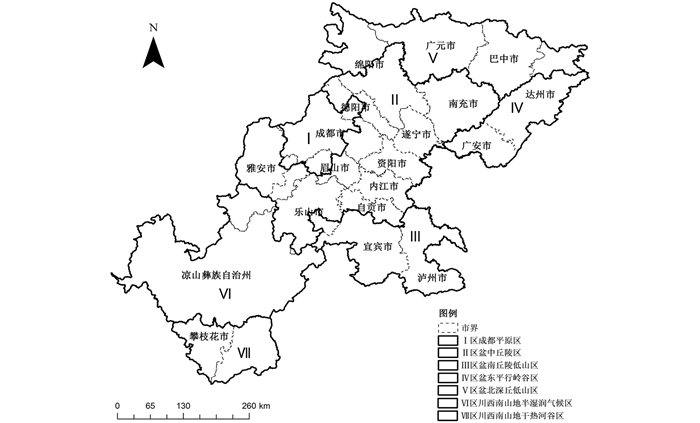
 下载:
下载:
